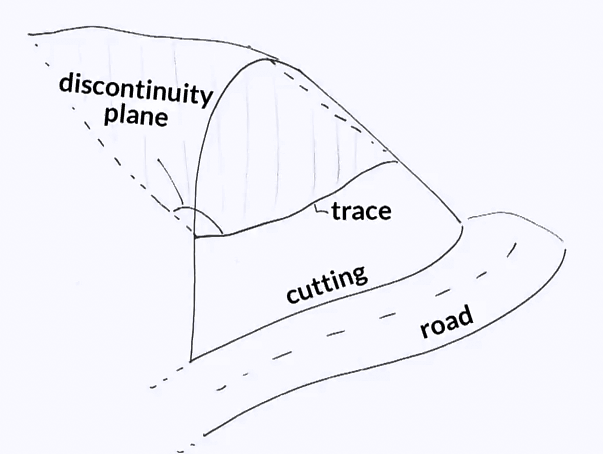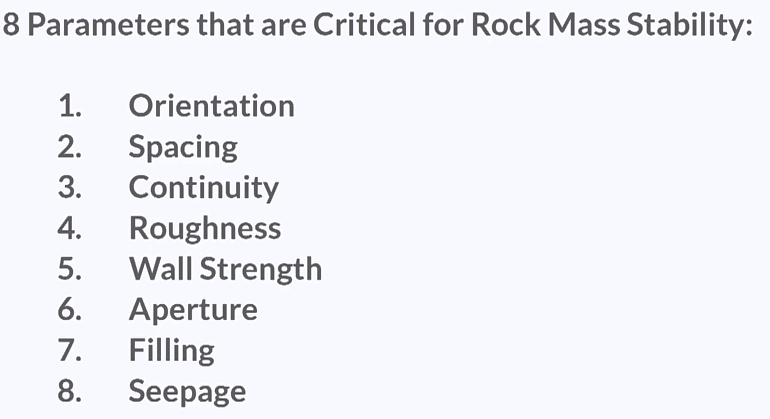Table of Contents
- The first one is the orientation
- The second parameter we’re interested in is the spacing
- The 3rd parameter is the continuity
- The fourth parameter is roughness
- The fifth parameter is the wall strength
- The sixth parameter is the aperture
- The seventh parameter is the filling
- The eighth parameter is the seepage
We have seen in the previous topics that discontinuities are critical for the behavior of a rock mass. Hence, for most engineering projects, it’s important to detect the presence of discontinuities and characterise the discontinuities. When it comes to the field, what we actually see of the discontinuities, most of the time, we see only the profile, as you can see on this figure here. This profile is called a trace, and that corresponds to the intersection between the discontinuity plane and a rock face. That could be a natural rock face or a cutting, like on this figure. The characterisation of the discontinuities is conducted by analysing their trace and different methods are possible for that. One option is simply to survey manually the discontinuities by sending people at the rock face, but that carries a risk of having rock fall and injuring the people involved in this operation. Another option is to drill some holed in the ground and retrieve specimens like this one and you could see here that we can clearly identify the presence of a discontinuity on this specimen here. Another option is to actually lower a camera in the borehole and record images of the rock in the borehole, and try to identify discontinuities. Finally, another option is just to go with remote operations like laser scanner or serial photography, and try to identify discontinuities through these images. The International Society for Rock Mechanics recommend characterizing eight parameters in relation to discontinuities to fully define them.
The first one is the orientation
What do we mean by orientation? If we have the plane of a discontinuity here, we need to know how inclined it is, and for given inclination, what is its orientation. So this inclination with respect to horizontal is called the dip and the orientation of the angle between the lines of steepest gradient projected on a horizontal plane taken with respect to the north measured clockwise gives you what’s called the dip direction. Dip and dip direction fully characterize the orientation of the discontinuity. So here we need to characterize dip and the dip direction. I have added a graph in the additional resources defining in a graphical manner what dip and dip directions are.
The second parameter we’re interested in is the spacing
A rock mass typically includes many discontinuities, come of which are parallel. This is the case on this figure with the horizontal discontinuities and the vertical discontinuities. The distance between discontinuties taken perpendicular from the discontinuity plane is called spacing. This spacing can be quite variable like for the vertical discontinuities on the figure or fairly constant like for the horizontal discontinuities on this figure. If there is a lot of variation in the spacing, on average value would be considered. Spacing is relevant for the behavior of the rock mass because the smaller the spacing, the higher the number of discontinuities and hence, the more the rock mass would be affected by the discontinuities.
The 3rd parameter is the continuity
Survey of discontinuities have shown that discontinuities aren’t always continuous. There might be some more rock bridges between joint segments that would confer extra strains to the discontinuity. This is illustrated in the photo here. The continuity is expressed as a ratio between the cumulative length of joint segments over the total length of the discontinuity.
The fourth parameter is roughness
We have seen in a previous topic that roughness plays a key role in the sheet’s strength of discontinuities. Here, roughness first has to be assessed as a large scale. The discontinuities have to be classified as planar, waved, or stepped. Then x-ray information is required at a small scale and the discontinuities could be rough, smooth, or slicken sided, which means polished.
The fifth parameter is the wall strength
Wall strength is an important parameter, because it contributes to the sheer strength of the discontinuity and has to be qualified. It’s quantified by an indirect method called a Schmidt hammer where a steel ball is bounced against the rock and the height of the rebound is measured and the higher the rebound, the stronger the rock.
The sixth parameter is the aperture
It is a distance between the two walls of the joint. Aperture is illustrated in this photo and you can see that it might vary significantly for different discontinuities again, just for one discontinuity. In this case, an average value might be used. Aperture is relevant for stability of a rock mass, because typically, the more open a joint, the less strength it will have. This is because aperture limits the interaction between the two walls of a discontinuity.
The seventh parameter is the filling
This pertains to the mental that could be find inside a discontinuity. It has to be characterized in situ the thickness of the filling would be measured, and then some material would be brought back to the laboratory where extra characterization would be performed. For example, the amount of moisture, particle size, and the mineralogy of the material.
The eighth parameter is the seepage
This is about information about the amount of water in a given site. There is information to provide for at the large scale for a site in the study, but also, locally into the discontinuities, how much water is flowing in the discontinuities. The seepage information consists of a rating from 1 for very tight discontinuity where there is no obvious flow of water, so a dry discontinuity, to six, highest value, for a discontinuity where water flows continuously.
These eight parameters are important because they help to define the potential and stable blocks in a rock mass. They help defining the number of sets of discontinuities. They help to classify the rock mass and they also contribute to the quantification of the rock mass strength and deformability. All these aspects will be covered in later topics.
https://youtu.be/cXBESk1MLik
